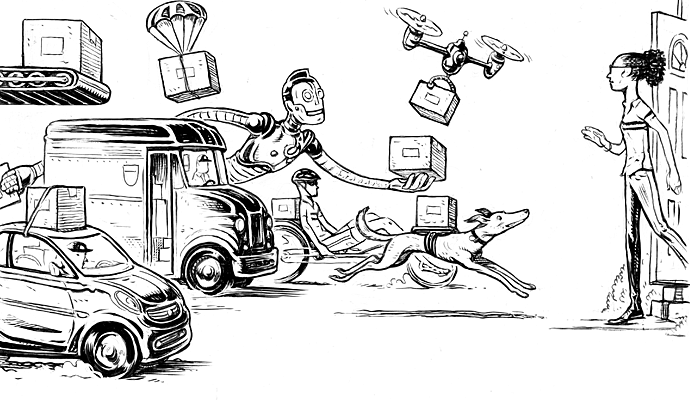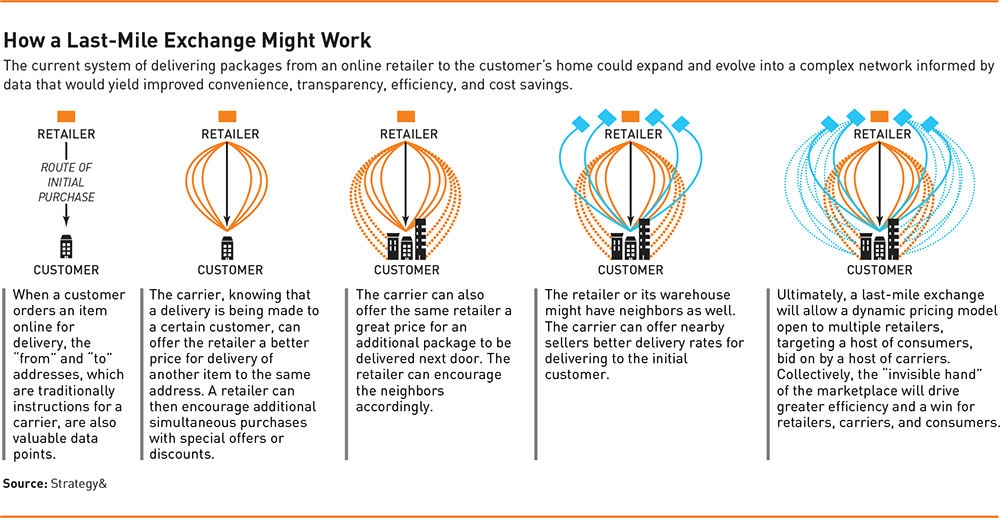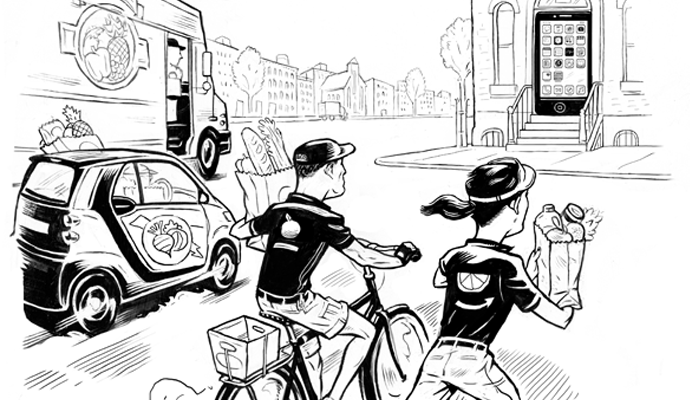The rise of the last-mile exchange
Keeping up with the growing volume of e-commerce will require delivery companies to disrupt their long-standing business model.
Park yourself at a typical residential intersection in the U.S., and you’ll watch a parade of delivery vehicles pass by over the course of the day. Trucks from FedEx, UPS, and the U.S. Postal Service (USPS) crisscross neighborhoods, retrieving and delivering packages, sometimes more than once. Increasingly, they are joined by trucks from regional shippers such as OnTrac or LaserShip, as well as by unmarked vehicles with non-uniformed drivers, who drop off packages for companies including Walmart and online startups such as Roadie, Doorman, and Sidecar. Soon, fleets of vans bearing Amazon’s logo, operated by independent companies, will be joining the mix.
The rising pace of activity along what’s called the last mile of the retail sales chain reflects the boom in e-commerce. According to the U.S. Census Bureau, e-commerce accounts for about 9 percent of total retail sales, and is growing at a double-digit clip. The number of packages delivered annually in the U.S. is expected to rise from 11 billion in 2018 to 16 billion by 2020, according to estimates from Strategy&, PwC’s strategy consulting business. B2C deliveries, generated mainly by e-commerce, account for more than half of today’s volume, and will make up two-thirds of volume by 2020. In many ways, this seems like a sunny story all around. Consumers have more shopping choices than they have ever had, and their online purchases are delivered faster than seemed possible just a few years ago. Retailers can reach many new customers, and are better able to serve existing customers with faster and more flexible distribution chains. Transportation companies are riding a powerful wave of new demand for their services.
But all this growth brings some peril. Retailers and transportation companies alike are facing challenges in this fast-changing marketplace. Both sectors are at risk from Amazon. The company is the behemoth of the e-commerce boom, with 100 million Amazon Prime members, and accounts for 25 percent of all U.S. packages today, on track to reach 50 percent by 2020. With a vertically integrated network that provides inherent advantages, Amazon is positioning itself to dominate both the retail and the transportation sides of the business.
A second threat to retailers and transportation providers is more systemic. The traditional ways of managing the delivery of packages — with hub-and-spoke ground networks, massive regional distribution facilities, and fleets of vehicles — were designed to optimize long-distance, intercity shipping. As a result, they are not well suited to the emerging realities of expanded e-commerce, in which the trend is increasingly local (trips of less than 50 miles are growing at a 25 percent annual rate). Furthermore, transportation companies struggle to accommodate fluctuations in last-mile demand. Peak shipping volume in December, for example, is more than 25 percent higher than in September, which causes shippers to scramble to hire tens of thousands of temporary employees and add capacity every year. Daily swings can be far higher; volume on some days in holiday seasons is an order of magnitude higher than the daily average.
Meanwhile, new delivery approaches — such as stores hiring their own delivery personnel and startups crowdsourcing delivery vehicles and drivers — can operate effectively only on a very local basis, and they gain few advantages by building scale geographically.
For all these reasons, devising a better solution to last-mile delivery will be the next major battle in e-commerce supremacy. To compete effectively against Amazon’s advantage, retailers and transportation providers will need to develop a way to better coordinate and more accurately match demand for the delivery services they can profitably supply on a given day.
The solution is to build a “last-mile exchange” platform that drives delivery decisions, and, crucially, allows retailers and transportation providers to collectively shape delivery demand and adjust continually to the inherent variability of the last mile. Such an exchange could deliver a win for consumers, retailers, and transportation providers. FedEx and UPS are the companies best positioned to disrupt their own business and create this new paradigm. Each could bring a significant share of the overall transactions to the platform. And each has a great deal to gain by evolving from a commodity provider with large fixed costs into a nimbler player that can compete against Amazon, aggressive regional players, or upstarts working out of the proverbial garage.
The Last-Mile Dilemma
The difficulty of delivering merchandise in a cost-effective way on the last mile of the retail sales chain has bedeviled e-commerce from its beginnings. Hazards in the last mile killed off many of the Internet startups in the late 1990s and early 2000s, such as Webvan (see “The Last Mile to Nowhere: Flaws & Fallacies in Internet Home-Delivery Schemes,” s+b, July 1, 2000). But despite the growth and evolution of e-commerce since then — along with the advent of smartphones, apps, and improved connectivity — the fundamental economics of the last mile haven’t changed. Profitability remains highly dependent on two key factors: (1) the transportation provider’s route density — how many packages can be delivered on a given delivery run, and (2) the drop size — how many packages or items are delivered at each stop.
Consider your own experience as an e-commerce consumer today. If you receive one package with a new thumb drive from the USPS on Tuesday morning, a package of beauty supplies from FedEx a few hours later, a book delivered by UPS on Wednesday, and a box of groceries from Walmart on Friday, it’s easy to appreciate the inherent inefficiencies in these four delivery trips. Imagine, instead, that a transportation provider could deliver all four of those packages from one truck, in one trip, at one time. Efficiency would soar, and per-package shipping costs would be roughly 50 percent lower, which could result in lower costs for consumers and higher margins for retailers, transportation providers, or both.
It’s clear that traditional legacy couriers such as FedEx, UPS, and the USPS (which is both a public-sector competitor and a partner, because FedEx and UPS, along with Amazon, offload a significant percentage of their last-mile deliveries to the postal service) are being pressured to keep up with demand. Historically, as in manufacturing, building scale was the primary lever for lowering last-mile costs. But today, the rising tide of e-commerce threatens to swamp the biggest commercial ships. The more that big retailers such as Amazon, Walmart, and Target ship, the deeper the per-parcel shipping discount they expect. Legacy couriers have also been slow to utilize peak pricing; their revenue is typically tied to annual contracts with fixed prices. And declining margins make it hard to justify the last-mile investments needed to keep pace with growth.
Most responses to date have been reactive. OnTrac and LaserShip have grown rapidly by targeting smaller retailers (historically the more profitable customers) with offerings in high-volume service areas that are mispriced in a national network. Other players in the e-commerce marketplace are attempting to make the delivery–supply component of the cost equation more flexible. Crowdsourcing personal vehicles and delivery personnel is one way to offset the “fixed” nature of traditional transportation providers by matching delivery demand with more variable supply. Walmart has tested a variety of solutions, including curbside pickup (“click and collect”) as well as an “associate delivery” service, in which employees can opt in to deliver consumers’ purchases, using their personal vehicles, on their way home from work.
Target was so concerned about the last mile that in late 2017, it paid US$550 million for Shipt, a crowdsourced provider that was less than five years old. Amazon is leveraging its acquisition of Whole Foods to combine grocery with other e-commerce package offerings in order to increase route density. Not to be outdone, Walmart is adding “pickup towers” to 500 of its U.S. stores in 2018 to concentrate demand into a single delivery point. These automated delivery hubs hark back to a concept we profiled more than 15 years ago (see “Oasis in the Dot-Com Delivery Desert,” s+b, July 1, 2001), in which players developed solutions to aggregate online purchases in secure neighborhood drop boxes instead of individual homes. Most of the startup ideas failed in the United States. But DHL has 3,000 “Packstations” throughout Germany, and about 90 percent of the German population can get to one within 10 minutes. Similar third-party delivery point concepts can be found in countries including Costa Rica and Latvia.
The difficulties of managing demand on a given day — which is especially evident at peak times such as Black Friday and holiday seasons — are built into the current e-commerce ecosystem. Transportation providers typically don’t know about a purchase until well after the online shopping cart transaction is complete. (How often have you tried to track a package on the FedEx or UPS website only to be informed that the shipper is awaiting information about the purchase?) Information is often siloed in the retail companies themselves, within order management, inventory management, and shipper transaction management systems — forcing delivery information later in the process.
When retailers have sales campaigns that create shipping surges, they don’t necessarily communicate the surging demand to their transportation providers. And even though shipping peaks can be massive for both retailers and transportation providers, the two players are independently guessing what the volume will be. As a result, retailers often place tremendous pressure on fulfillment and shipping resources.
Building a Last-Mile Exchange
The solution to this problem is a last-mile delivery exchange that connects consumers, retailers, and transportation companies via a digital platform. It could solve many of the difficulties challenging the e-commerce ecosystem today and produce benefits for consumers, retailers, and the package delivery providers, yielding improved convenience, transparency, efficiency, and cost savings. Such an exchange would create a path forward through the disruption caused by increasing consumer expectations, advances in technology, the emergence of new entrants, and the rise of the sharing economy [see the 2016 PwC report “Shifting Patterns: The Future of the Logistics Industry” (pdf)].
The exchange would effectively flip the script. Rather than react to demand and respond to others’ decisions, transportation companies and retailers could engineer demand earlier in the sales process and dynamically balance supply and demand, much as Uber uses surge pricing to encourage more drivers to work during times of peak needs in peak locations. Such a platform designed for e-commerce package delivery would need to be multisided, involving both retailers and last-mile transportation providers. Instead of passing on information from point to point in a linear fashion, it would need to dynamically share data among all the players. The exchange participants would need to have sophisticated algorithms that help them decide how much to bid to deliver a given package to a particular location on a particular day at a particular time. For example, assume a carrier already has a planned delivery of a dress from Nordstrom to a home in Dunwoody, outside Atlanta. That carrier could offer a great price to deliver an additional package to the house next door (from Nordstrom or another retailer) and an even better price for another delivery to the same customer. Accordingly, Best Buy might be willing to offer a discount on a television with excess inventory in Atlanta.
The last-mile platform would need to connect the retailers’ order management and inventory data with package and delivery resource data in real time. Because sending data from mainframe to mainframe will no longer be feasible, a cloud-based ecosystem would be optimal, pooling package data, resource availability data, and analytics with insights, and featuring dynamic optimization of pickup and delivery routes. Drawing another parallel, such a platform would need analytic sophistication comparable to that of the ecosystem that supports Google’s AdWords, which auctions key search terms billions of times each month to ensure the maximum value for both advertisers and consumers on Google’s search platform. Data security — including consumer privacy, protection of proprietary company data, and transaction security — would be critical. This strategy would pay multiple dividends.
An effective last-mile platform would need analytic sophistication comparable to that of the ecosystem that supports Google’s AdWords.
Consumers would benefit from seeing direct shopping incentives and options at the initial point of sale. And they would receive indirect shopping incentives because retailers would pass through shipper offers of lower-cost shipping on days when delivery demand is low. Consumers would generally also have more visibility into, and more interaction with, the entire delivery process.
Retailers would benefit from the power of aggregation, keeping their own online storefronts and identities but offering more and better shipping options through the last-mile exchange that would rival the experience that Amazon provides. Their shipping costs would fall.
Legacy couriers would build more flexible and efficient networks. Supply chains at FedEx and UPS are already highly optimized to deal with the fixed constraints designed into their existing networks. But the last-mile exchange would empower them to meet the challenge of managing supply chain costs despite the inherent variability in e-commerce volume growth. They would be able to see demand fluctuations earlier in the e-commerce sales process and shape demand with incentives, dynamic pricing, and real-time matching of resources. They could, in effect, reframe the problem to better design and utilize their fixed delivery fleets — minimizing the need for multiple trucks delivering packages on the same streets in a given time frame. (They might even create a secondary market swapping packages between networks to eliminate such redundant coverage.)
Disrupt Yourself
Although the proposed exchange may seem theoretical and futuristic, there is every reason for companies to act now to make it a reality. E-commerce volume will continue to boom, and the challenges facing transportation companies will become more serious. Consumer expectations have been reset since 2005, when Amazon introduced free two-day delivery for Amazon Prime customers. And expectations continue to escalate. Consumers now see two-day delivery as the default, and increasingly expect their purchases to arrive the day after they place their orders, or even on the same day. Just a few years ago, transportation companies were delivering packages only five days per week. UPS moved to six-day delivery in 2017. Amazon began arranging Sunday deliveries through a deal with the USPS in 2014 — and it’s inevitable that the entire package delivery business will move to a routine seven-day delivery cycle before long. The last mile of the retail sales chain will likely become even more crowded with more competitors.
The current e-commerce trajectory is pointing toward a future in which FedEx, UPS, and other transportation companies become commoditized players in a game whose odds favor other players. But acting now would enable companies to alter this trajectory. Creating a last-mile exchange would fundamentally disrupt the last-mile delivery business by addressing demand in a more sophisticated way. FedEx and UPS, as noted earlier, are best positioned to be the disruptors. Their significant shares of overall transactions, as well as their huge resource bases and highly evolved delivery capabilities, give them the stakes they would need to place such a large bet. It’s also possible that a consortium of retailers and transportation providers could band together to create an exchange. The specific details are also likely to evolve as blockchain technology becomes accepted more widely.
Finally, although consumers and retailers will see significant benefits if e-commerce delivery becomes more efficient, solving the last-mile dilemma may well be an existential challenge for transportation companies. Creating a new last-mile exchange would enable them to shape a future that would be more favorable to them.
Author profiles:
- Tim Laseter is a managing director at PwC US, and an advisor to executives for Strategy&, PwC’s strategy consulting business. Based in Arlington, Va., he is also a contributing editor of s+b, and a professor of practice at the University of Virginia’s Darden School. He is the author or coauthor of four books, including Internet Retail Operations.
- Andrew Tipping leads the U.S. transportation team for Strategy&. Based in Chicago, he is a principal with PwC US.
- Frederick Duiven specializes in advising transportation clients on growth strategies for Strategy&. Based in Arlington, Va., he is a director with PwC US.




